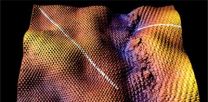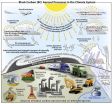(Press-News.org) AUSTIN, Texas — Researchers at The University of Texas at Austin have developed a menu of 61 new strains of genetically engineered bacteria that may improve the efficacy of vaccines for diseases such as flu, pertussis, cholera and HPV.
The strains of E. coli, which were described in a paper published this month in the journal PNAS, are part of a new class of biological "adjuvants" that is poised to transform vaccine design. Adjuvants are substances added to vaccines to boost the human immune response.
"For 70 years the only adjuvants being used were aluminum salts," said Stephen Trent, associate professor of biology in the College of Natural Sciences. "They worked, but we didn't fully understand why, and there were limitations. Then four years ago the first biological adjuvant was approved by the Food and Drug Administration. I think what we're doing is a step forward from that. It's going to allow us to design vaccines in a much more intentional way."
Adjuvants were discovered in the early years of commercial vaccine production, when it was noticed that batches of vaccine that were accidentally contaminated often seemed to be more effective than those that were pure.
"They're called the 'dirty little secret' of immunology," said Trent. "If the vials were dirty, they elicited a better immune response."
What researchers eventually realized was that they could produce a one-two punch by intentionally adding their own dirt (adjuvant) to the mix. The main ingredient of the vaccine, which was a killed or inactivated version of the bacteria or virus that the vaccine was meant to protect against, did what it was supposed to do. It "taught" the body's immune system to recognize it and produce antibodies in response to it.
The adjuvant amplifies that response by triggering a more general alarm, which puts more agents of the immune system in circulation in the bloodstream, where they can then learn to recognize the key antigen. The result is an immune system more heavily armed to fight the virus or bacteria when it encounters it in the future.
For about 70 years the adjuvant of choice, in nearly every vaccine worldwide, was an aluminum salt. Then in 2009, the FDA approved a new vaccine for human papillomavirus (HPV). It included a new kind of adjuvant that's a modified version of an endotoxin molecule.
These molecules, which can be dangerous, appear on the cell surface of a wide range of bacteria. As a result, humans have evolved over millions of years to detect and respond to them quickly. They trigger an immediate red alert.
"In some of its forms an endotoxin can kill you," said Trent. "But the adjuvant, which is called MPL, is a very small, carefully modified piece of it, so it's able to trigger the immune response without overdoing it."
What Trent and his colleagues have done is expand on that basic premise. Rather than just work with an inert piece of endotoxin, they've engineered E. coli bacteria to express the endotoxin in many configurations on the cell surface.
"These 61 E. coli strains each have a different profile on their surface," said Brittany Needham, a doctoral student in Trent's lab and the first author on the paper. "In every case the surface structure of the endotoxin is safe, but it will interact with the immune system in a range of ways. Suddenly we have a huge potential menu of adjuvants to test out with different kinds of vaccines."
One form might work better with cholera vaccine, another with pertussis (whooping cough) and another with a future HIV vaccine. Trent, Needham and their colleagues should be able to fine-tune the adjuvants with increasing precision as more E. coli strains are engineered and tested, and as their understanding of how they interact with the immune system deepens.
"I think we're at the dawn of a new age of vaccine design," said Trent. "For a long time vaccinology was really a trial-and-error field. It was a black box. We knew certain things worked. We knew certain vaccines had certain side effects. But we didn't entirely know why. Now that's changing."
Trent said that an additional advantage of their system is that the E. coli can be engineered to express key viral and bacterial antigens along with the endotoxin. A single cell could deliver both parts of the one-two punch, or even a one-two-three punch, if antigens from multiple diseases were expressed in a single E. coli.
"It makes possible a vaccine that provides protection from multiple pathogens at the same time," said Trent.
Trent and his colleagues are working on a second round of designer E. coli. They have also filed a provisional patent on their system and are working with the university to find a corporate partner to pay for clinical trials.
"This is ready to go," said Trent. "I can't predict whether it will actually make it to the market. But it's very similar to the adjuvant that has already been approved, and my instinct is that if a company will undertake to do the trials, it will get approved. A company could call us tomorrow, we could send them a strain, and they could start working."
INFORMATION:
Designer bacteria may lead to better vaccines
61 new strains of genetically engineered bacteria may improve the efficacy of vaccines for diseases such as flu, pertussis, cholera and HPV
2013-01-15
ELSE PRESS RELEASES FROM THIS DATE:
Chemistry resolves toxic concerns about carbon nanotubes
2013-01-15
Safety fears about carbon nanotubes, due to their structural similarity to asbestos, have been alleviated following research showing that reducing their length removes their toxic properties.
In a new study, published today in the journal Angewandte Chemie, evidence is provided that the asbestos-like reactivity and pathogenicity reported for long, pristine nanotubes can be completely alleviated if their surface is modified and their effective length is reduced as a result of chemical treatment.
First atomically described in the 1990s, carbon nanotubes are sheets of ...
Born to lead? Leadership can be an inherited trait, study finds
2013-01-15
Genetic differences are significantly associated with the likelihood that people take on managerial responsibilities, according to new research from UCL (University College London).
The study, published online in Leadership Quarterly, is the first to identify a specific DNA sequence associated with the tendency for individuals to occupy a leadership position. Using a large twin sample, the international research team, which included academics from Harvard, NYU, and the University of California, estimate that a quarter of the observed variation in leadership behaviour ...
Neon lights up exploding stars
2013-01-15
An international team of nuclear astrophysicists has shed new light on the explosive stellar events known as novae.
These dramatic explosions are driven by nuclear processes and make previously unseen stars visible for a short time. The team of scientists measured the nuclear structure of the radioactive neon produced through this process in unprecedented detail.
Their findings, reported in the US journal Physical Review Letters, show there is much less uncertainty in how quickly one of the key nuclear reactions will occur as well as in the final abundance of radioactive ...
New research gives insight into graphene grain boundaries
2013-01-15
Using graphene – either as an alternative to, or most likely as a complementary material with – silicon, offers the promise of much faster future electronics, along with several other advantages over the commonly used semiconductor. However, creating the one-atom thick sheets of carbon known as graphene in a way that could be easily integrated into mass production methods has proven difficult.
When graphene is grown, lattices of the carbon grains are formed randomly, linked together at different angles of orientation in a hexagonal network. However, when those orientations ...
Facebook posts not easily forgotten
2013-01-15
Facebook posts resonate significantly more with human nature than books or even human faces, according to a new study by Laura Mickes and colleagues from the University of California San Diego in the US. The difference in memory between these microblogs and actual published words from a page is as striking as the difference in memory between amnesiacs and healthy controls. The work is published online in Springer's journal Memory & Cognition.
Online social networking is very popular, and allows people to post their thoughts as microblogs, an opportunity that people exploit ...
The muscle response of footballers depends on their position on the field
2013-01-15
Football players display different muscle response parameters depending on the position that they hold on the pitch, according to a study conducted by a team of Spanish researchers which has been published in the 'Journal of electromyography and kinesiology'.
Scientists from the University of Vigo have analysed different muscle response parameters in 78 Spanish first division footballers who have been playing for between four and fifteen years. They found variations depending on the field position of the players.
Published in the 'Journal of Electromyography and Kinesiology', ...
Black carbon larger cause of climate change than previously assessed
2013-01-15
Black carbon is the second largest man-made contributor to global warming and its influence on climate has been greatly underestimated, according to the first quantitative and comprehensive analysis of this issue.
The landmark study published in the Journal of Geophysical Research-Atmospheres today says the direct influence of black carbon, or soot, on warming the climate could be about twice previous estimates. Accounting for all of the ways it can affect climate, black carbon is believed to have a warming effect of about 1.1 Watts per square meter (W/m2), approximately ...
No panaceas for Mexico's violent drug war, but prohibition has failed
2013-01-15
While Mexico and the United States have ramped up their efforts to control and perhaps defeat Mexico's increasingly violent drug cartels, the outcome of these efforts remains in doubt and no panaceas are in sight, but prohibition has once again proved to be a failure, according to a paper from Rice University's Baker Institute for Public Policy.
The paper by Rice sociologist William Martin, "Cartels, Corruption and Carnage in the Calderón Era," traces the origins and growth of Mexican drug cartels and the corruption, failed government policies and gruesome violence ...
In search of the big questions: Conserving the European Alps
2013-01-15
The European Alps range span eight countries from France to Slovenia and harbour an extraordinary diversity of habitats, plants and animals, including many species found nowhere else. They are widely considered to be one of the most important regions for the preservation of biodiversity in Europe. But the Alps are not just a natural paradise: they are the home and workplace of up to 14 million people and the destination for more than 100 million tourists each year. The resulting changes to the landscape have led to an increasing fragmentation of the plant and animal ...
EGFR mutation not prognostic factor in non-small cell lung cancer
2013-01-15
DENVER – Recent studies have demonstrated that molecular-targeted agents, such as epidermal growth factor receptor (EGFR) tyrosine kinase inhibitors (TKI), may prolong survival of selected patients based on tumor biomarkers. The presence of mutation in the EGFR gene is known as a predictive marker for the response to treatment. However, whether or not these EGFR mutations are prognostic factors for non-small cell lung cancer (NSCLC) has not been known. A recent study published in the February 2013 issue of the International Association for the Study of Lung Cancer's (IASLC) ...
LAST 30 PRESS RELEASES:
Making lighter work of calculating fluid and heat flow
Normalizing blood sugar can halve heart attack risk
Lowering blood sugar cuts heart attack risk in people with prediabetes
Study links genetic variants to risk of blinding eye disease in premature infants
Non-opioid ‘pain sponge’ therapy halts cartilage degeneration and relieves chronic pain
AI can pick up cultural values by mimicking how kids learn
China’s ecological redlines offer fast track to 30 x 30 global conservation goal
Invisible indoor threats: emerging household contaminants and their growing risks to human health
Adding antibody treatment to chemo boosts outcomes for children with rare cancer
Germline pathogenic variants among women without a history of breast cancer
Tanning beds triple melanoma risk, potentially causing broad DNA damage
Unique bond identified as key to viral infection speed
Indoor tanning makes youthful skin much older on a genetic level
Mouse model sheds new light on the causes and potential solutions to human GI problems linked to muscular dystrophy
The Journal of Nuclear Medicine ahead-of-print tip sheet: December 12, 2025
Smarter tools for peering into the microscopic world
Applications open for funding to conduct research in the Kinsey Institute archives
Global measure underestimates the severity of food insecurity
Child survivors of critical illness are missing out on timely follow up care
Risk-based vs annual breast cancer screening / the WISDOM randomized clinical trial
University of Toronto launches Electric Vehicle Innovation Ontario to accelerate advanced EV technologies and build Canada’s innovation advantage
Early relapse predicts poor outcomes in aggressive blood cancer
American College of Lifestyle Medicine applauds two CMS models aligned with lifestyle medicine practice and reimbursement
Clinical trial finds cannabis use not a barrier to quitting nicotine vaping
Supplemental nutrition assistance program policies and food insecurity
Switching immune cells to “night mode” could limit damage after a heart attack, study suggests
URI-based Global RIghts Project report spotlights continued troubling trends in worldwide inhumane treatment
Neutrophils are less aggressive at night, explaining why nighttime heart attacks cause less damage than daytime events
Menopausal hormone therapy may not pose breast cancer risk for women with BRCA mutations
Mobile health tool may improve quality of life for adolescent and young adult breast cancer survivors
[Press-News.org] Designer bacteria may lead to better vaccines61 new strains of genetically engineered bacteria may improve the efficacy of vaccines for diseases such as flu, pertussis, cholera and HPV



